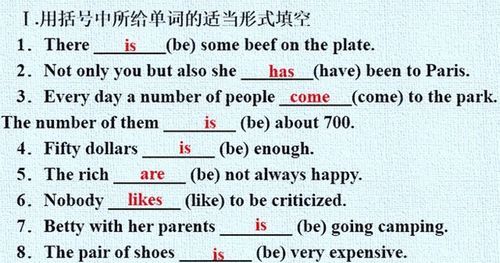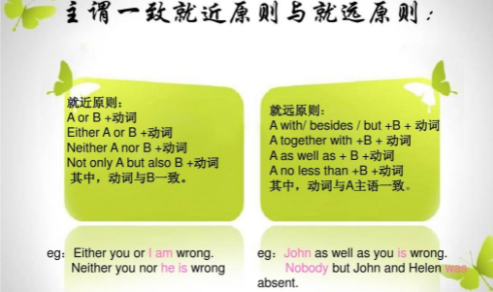本文目录
英语语法中的就近原则
首先 either.....or 是就近原则:Either he or I am an alien.(要么他,要么我是外星人。)其次 neither...nor是就近原则:Neither he nor I am an alien.(我和他都不是外星人。)而且 Either of us is teacher. 我们两个中有一个是老师。 这里用不管什么情况,都是 IS。同理 Neitehr of us is teacher.我们两个每一个是老师。另外还有, Both ... and....+ are Not only you but also I am.....(就近的) I as well as he am teacher.(就远的)前面的是两者,只要记住、理解就可以了 。下面是两者以上的。None of + is All of + are 关键是积累、理解,说白了就是被出来。。。 希望对你有用。Wish you success~

therebe的就近原则是什么
either…or…连接两个主语时,其谓语动词应与最近的一个主语在人称和数上保持一致,这就是通常说的"就近原则"。
例如:Are either you or I going there tomorrow? 明天是你还是我去那里?
Either you or he has lunch at school. 其一般疑问句应为:Do either you or he have lunch at school? 是你还是他在学校吃午饭?

双语例句
1. We fight, or we don't, it's an either - or decision.
我们要么打, 要么不打, 非此即彼,没有别的出路。
2. The alternative option is a structured bankruptcy of either or both firms.
替代选择是结构性破产一方或双方公司。
3. IS THE RESISTANCE ABOVE 0 OHMS ON EITHER OR BOTH CIRCUITS?
是否任一个或二电路的电阻在5.0HMS以上?
eitherorneithernorasasnot soas的就近原则怎么用
就近原则即:谓语与靠近的名词、代词(有时不一定是主语)在“人称、数”上一致。
用的时候分两种情况:
I.
在正式文体中:
1.由下列词语连接的并列主语:"there be+句型; or ; either …or;nor; neither…nor;whether…or;not…but; not only…but also" ; 等。e.g. ①What he does or what he says does not concern me . 他的行为或言谈都与我无关。 ②Neither you nor I am wrong . 你和我都没错。 ③Not you but your father is to blame . 不是你,而是你父亲该受责备。 ④Not only you but(also) he is wrong .不仅你错了,他也错了。
2. 在倒装句中:谓语可与后面第一个主语一致。e.g. ①In the distance was heard the clapping of hands and the shouts of the people . 在远处,能听见鼓掌声和人们的呼喊声。 ②There is (are) a pen and some books on the desk .桌上有一支钢笔和几本书。
II.
非正式文体中: 有时依“就近一致原则”,但也可依“意义一致原则”或严格地依“语法一致原则”。e.g. Neither she nor I were there (意义一致) 我和他当时都不在那儿。(非正式) Neither she nor I was there .(就近一致)(译文同上句)(正式) 但是,如果依“就近一致原则”而与其他两项原则相矛盾时,则常常认为是不太合符规范的。e.g. No one except his own supporters agree with him .仅他自己的支持者同意他的意见。(依“就近”和“意义”一致的原则;但语法上,“No one ”才是主语,谓语要改成“agrees”。“写作中”一般要依“语法一致”原则。

neithernor和eitheror后面谓语动词的用法
就近原则即句子的谓语动词的单复数与nor或者or后面的名词的单复数决定,下面举两个例子。
Neither you nor Tom likes running.(你和Tom都不喜欢跑步)该句子中谓语动词like的单复数与nor后面的人称保持一致。
Either the apple or the pear is OK.(苹果和梨都可以)该句子的谓语动词是第三人称单数,与or后面的pear保持一致。

非正式文体
有时依“就近一致原则”,但也可依“意义一致原则”或严格地依“语法一致原则”。
例句:
Neither she nor I were there. (意义一致) 我和她当时都不在那儿。(非正式)
Neither she nor I was there .(就近一致)(译文同上句)(正式)
但是,如果依“就近一致原则”而与其他两项原则相矛盾时,则常常认为是不太合符规范的。
以上就是关于eitheror就近一致例题 ,英语语法中的就近原则的全部内容,以及either…or就近一致例题 的相关内容,希望能够帮到您。

